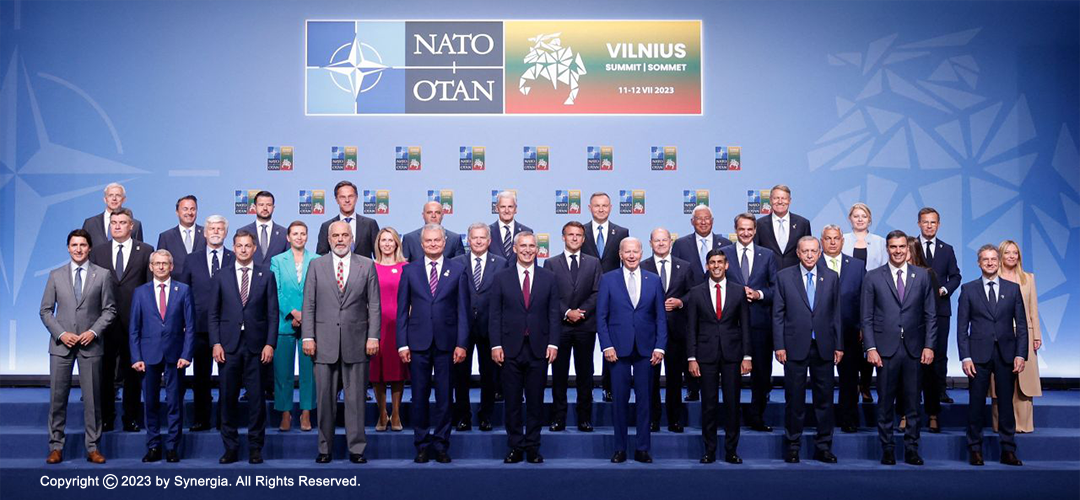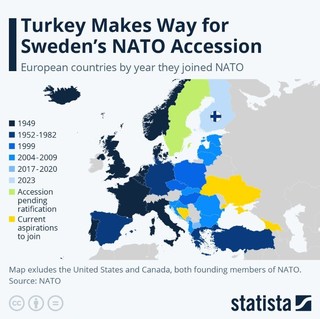Nato: Gearing Up for a Conflicted Future
July 22, 2023 | Expert Insights

The NATO Summit 2023 was held in Vilnius, Lithuania, on July 11-12, 2023. The Summit was attended by the leaders of all 30 NATO member countries and the leaders of Finland and Sweden, who are both seeking to join the Alliance.
Held under the shadow of the intractable conflict in Ukraine, which the bloc has been proxy fighting for over a year and a half now, the decisions arrived at the Summit were keenly awaited by the world.
Some decisions that have been made public include- deploying four new battlegroups to Romania, Bulgaria, Hungary, and Slovakia, establishing a new NATO command centre in Poland, and deploying more troops and equipment to existing NATO bases in Eastern Europe. These measures are designed to deter Russia from further aggression against NATO members and send a clear message that NATO is committed to defending its allies.
Background
Obliviously, the Summit was dominated by the war in Ukraine, and a visibly exhausted yet determined Europe pledged to continue the military and financial assistance to Ukraine. Also, a number of measures were announced to strengthen NATO's deterrence and defence posture in response to the Russian threat.
One of the most significant decisions made at the Summit was to increase the size of NATO's rapid reaction force to 300,000 troops. This force will be made up of troops from all NATO member countries and will be able to deploy quickly to any part of the Alliance that is threatened.
The NATO Summit 2023 saw the decision to create a new multinational and multi-domain Allied Reaction Force (NRF). This new force will be able to operate in all domains, including land, sea, air, space, and cyber. The creation of this new force is a sign of NATO's commitment to adapting to the challenges of the 21st Century. This force will be more flexible and adaptable than the existing rapid reaction force and will be able to respond to a wider range of threats. The NRF is also a sign of NATO's commitment to burden-sharing. The force will be made up of troops from all NATO member countries, which will help to ensure that the costs of the force are shared fairly.
The Summit also saw the adoption of a new NATO Strategic Concept. This document outlines the Alliance's vision for the future and its commitment to deterring and defending against any threat to its members. The Summit successfully reaffirmed the Alliance's commitment to security and defence. The Summit's decisions will help ensure that NATO remains a strong and effective deterrent against any aggressor.

Analysis
The NATO leaders reiterated their commitment to Article 5 of the NATO Treaty, which states that an attack on one member is an attack on all members. This was a message to Russia and its ally Belarus (with its newfound Wagner force) not to intrude into any other country, especially Poland.
The bloc has acknowledged China's growing military power as a major challenge to the security of NATO and its partners in the Indo-Pacific region. China's militarization of the South China Sea and its increasingly assertive claims in the East China Sea have raised concerns about its intentions. The NATO leaders cautioned China that it should not challenge the rules-based international order. NATO has indicated that it will strengthen its presence in the Indo-Pacific to counter aggressive Chinese behaviour. This could have come out of a bit of pushing by the U.S. In any case, this would be good news for impacted nations like the Philippines, Vietnam, Indonesia, Taiwan and India. NATO has announced its willingness to work with 'partners in the region to promote a free and open Indo -Pacific.' This cooperation that extends NATO's military footprint from the Atlantic to the Indo-Pacific can potentially change the security landscape in the 21st Century.
Expanding NATO's Charter to include China (the original objective of NATO being only the Soviet threat in continental Europe) has not been universally welcomed in all European countries, especially those who are recipients of China's BRI munificence or fear that expanding the role of NATO would entail a hefty hike in their defence spending. Calmer voices are calling the move an overreaction to China's expected economic and military power growth and have advocated restricting NATO's focus on its traditional mission of deterring Russia. Others argue that NATO should not engage with China at all, as this could only legitimize China's claims in the Indo-Pacific region.
Assessment
- The future of NATO is uncertain, but the Alliance appears to be united and comfortably poised to face the challenges of the 21st Century. NATO has a strong track record of adapting to change, and it is confident that it will be able to continue to do so in the years to come.
- For far too long, NATO nations have enjoyed the benefits of an overarching security umbrella provided by the U.S., thus keeping their defence budgets and commitments to the bare minimum. These are violent times again in Europe, and a paradigm shift in the bloc's strategy is the only way ahead. This is reflected in the new European Defence Strategy unveiled last year.
- At no other time since the Nazi invasion did Europe require greater unity than now to face up to the threat of war. President Biden well encapsulated this when he said," We will not waver.” This was exemplified by the smooth induction of Sweden after a complete reversal of stand by President Erdogan, thanks to some gentle persuasion bu President Biden.








Comments